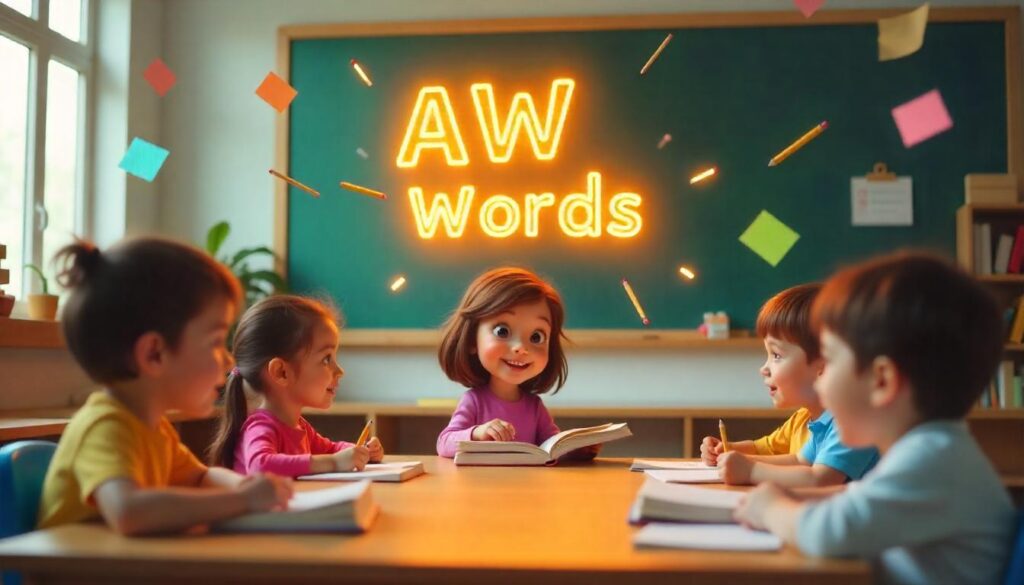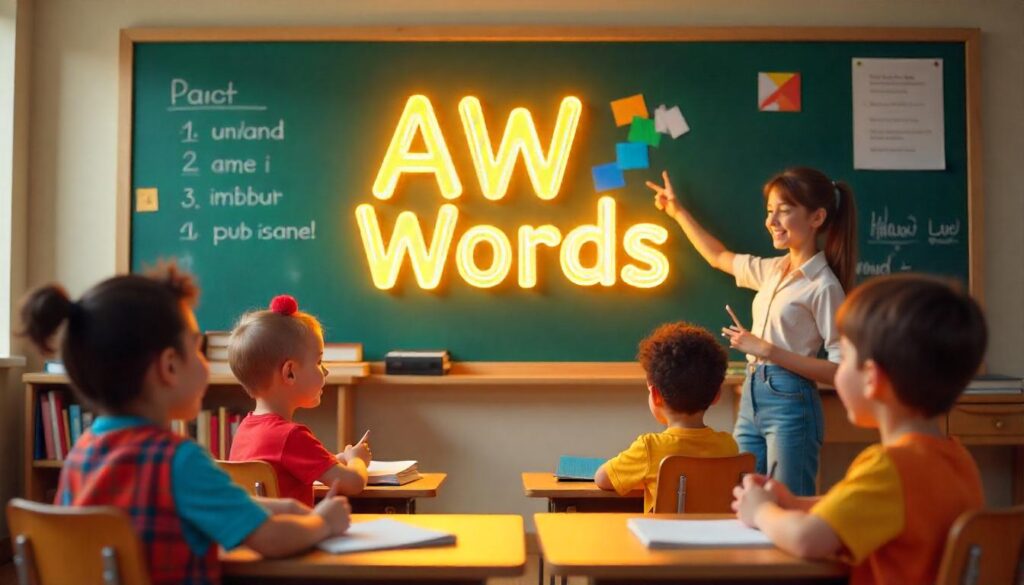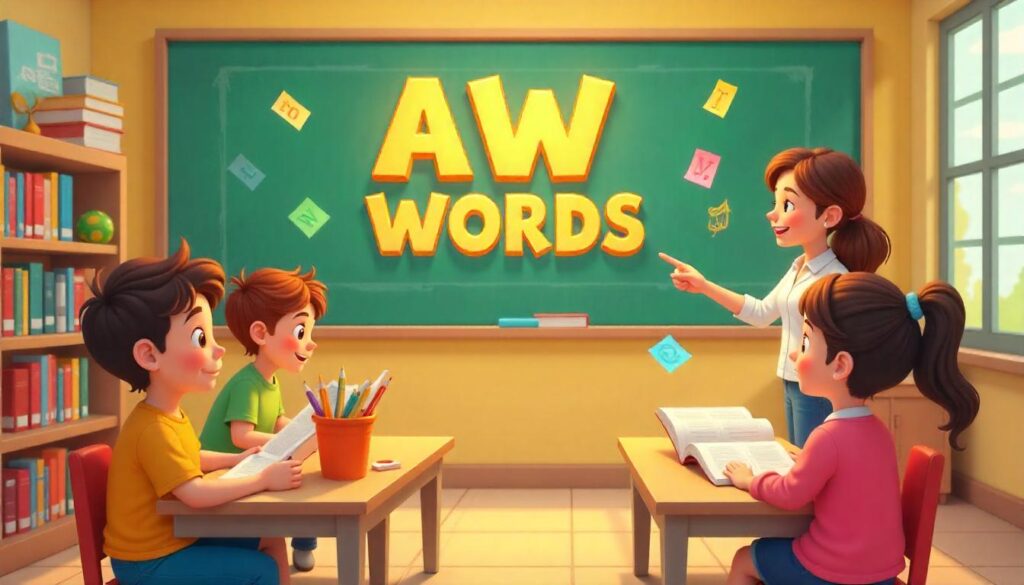Have you ever sat with a young reader who suddenly grins and shouts “Awww!” at the sight of a puppy in their book—and then asks, “Is that the same ‘aw’ in saw?”
That’s when you know it’s time to dive into aw words.
Whether you’re a teacher shaping young minds, a homeschooling parent navigating phonics, or just someone trying to make reading a little easier and more fun for a curious child, you’re in the right place. Learning the “aw” sound can actually be a delightful part of early literacy, and with the right tools, it’s easier than you think.
What Are “Aw Words” Anyway?
Let’s start with the basics. “Aw words” are words that include the “aw” digraph—a pair of letters that together make a single sound. Think: claw, draw, straw, paw. This sound is commonly taught in early phonics programs like Read Write Inc. (RWI) and plays a big role in helping young learners decode words confidently.
But here’s where things get interesting: this isn’t just about memorizing a list. Teaching “aw” words is about building a bridge between sound and meaning. It’s about giving children the tools to hear a word and know how to spell it—and vice versa.
Keyword Biography Table: “aw words”
| Field | Information |
|---|---|
| Keyword | aw words |
| Search Intent | Educational – mainly phonics and early literacy learning |
| Audience | Teachers, homeschooling parents, early learners, English language learners |
| Related Keywords | aw sound words, phonics aw words list, teaching aw sound, aw and au words |
| Content Types Ranking | Worksheets, activities, lesson plans, phonics-based books, teaching blogs |
| Top Competitor Domains | tes.com, teacherspayteachers.com, education.com, amazon.com, scholastic.com |
| Popular Questions (PAA) | How to teach “aw” sound? What are examples of “aw” words? Are “aw” and “au” the same? |
| Trending Use Cases | Classroom phonics lessons, home reading practice, Read Write Inc. programs |
| Phonetic Category | Digraph (vowel combination creating a specific sound) |
| User Challenges | Making lessons fun, finding quality resources, engaging young readers |
| Long-Tail Opportunities | aw words for kindergarten, sentences with aw words, activities for aw words |
| Search Trend Status | Steady relevance due to ongoing focus on phonics in early education |

Why the “Aw” Sound Matters in Phonics Education
When a child learns to read, they’re not just memorizing letters—they’re cracking a code. And the “aw” sound is part of that phonics puzzle.
In fact, many educators use “aw” words as a stepping stone in phonics instruction, especially during the kindergarten and first-grade years. According to the top-ranking educational sites on Google, there’s a huge demand for activities, games, and worksheets that focus specifically on this sound.
And that makes sense. Phonics instruction is all about patterns—and the “aw” sound is a consistent, friendly one. It often shows up at the end of words or syllables (like in straw or flaw), making it relatively easy to spot and teach.
Who’s Searching for “Aw Words”—and Why?
According to recent Google trends and search analysis, most people searching for “aw words” fall into one of three groups:
- Teachers and homeschooling parents looking for worksheets, games, or lesson plans
- Parents trying to support their child’s reading at home
- Students, usually in the early grades, working on a spelling list or classroom assignment
And there’s also a quieter group—English language learners—who are often seeking help with pronunciation. For them, understanding how “aw” sounds can improve both reading and speaking skills.
Teaching the “Aw” Sound: Practical and Creative Approaches
There’s no shortage of ways to make the “aw” sound fun and memorable. Let’s break it down by category.
Worksheets and Word Lists
These are the bread and butter of early literacy. Simple worksheets that match pictures to “aw” words, fill-in-the-blank activities, or even word searches help kids engage visually and cognitively.
Common aw words for beginners include:
- Paw
- Claw
- Straw
- Draw
- Lawn
- Yawn
- Saw
- Jaw
- Flaw
These words are ideal for spelling practice, matching games, and even short story writing.
Interactive Games and Phonics Activities
Learning sticks when it’s fun. Use games like:
- “Aw” Word Bingo
- Roll-a-Word Dice Games (with “aw” endings)
- Word sorting: separating “aw” vs “au” words to spot sound patterns
Many teachers also use apps or digital whiteboards to play interactive phonics games in class or over Zoom. (Yes, virtual learning has made phonics go digital!)

Read-Aloud Time with “Aw” Word Books
Books are a natural place to reinforce new sounds. Look for phonics readers focused on the “aw” digraph, many of which are available through Amazon or Scholastic.
One favorite among early readers:
“Strawberries and the Big Claw” — a silly, engaging story that features tons of “aw” words without feeling forced.
“Aw” vs “Au”: Clearing Up the Confusion
If your little learner asks, “Wait—is cause an ‘aw’ word too?” … you’re not alone.
This is a great teachable moment. Both “aw” and “au” make the same /ɔː/ sound, like in saw and haul, but they’re spelled differently. A quick activity: make two columns, one for “aw” and one for “au,” and let kids sort words like claw, paw, haul, fault, etc.
It’s like a mini detective game—and kids love solving sound puzzles.
Story Time: A Real-World “Aw” Word Moment
Here’s a story from a real classroom:
“One day during circle time, my student Ava drew a cat with huge claws and said it was ‘the law enforcer of the jungle.’ I couldn’t stop smiling—not just because it was adorable, but because she had unknowingly used three ‘aw’ words in one sentence.”
That’s the power of phonics done right—it sticks without feeling like a chore.
Where to Find the Best “Aw” Word Resources
If you’re wondering where to get top-quality materials for teaching “aw” words, look no further than:
- Teachers Pay Teachers (teacherspayteachers.com) – Thousands of affordable (and even free) downloadable resources created by real educators.
- Tes.com – A UK-based resource hub with phonics plans, especially useful for Read Write Inc. alignment.
- Education.com – Offers printable worksheets, games, and guided lessons.
- Amazon – Great for early reader books and flashcard sets.
- Lesson Planet and Scholastic – Solid choices for finding classroom-tested curriculum support.
Long-Tail Keywords Worth Targeting (Hint: They Bring More Traffic)
If you’re creating your own educational content or blog, consider adding some of these long-tail keyword variations:
- “aw sound words for kindergarten”
- “phonics worksheets for aw words”
- “teaching the aw digraph in Read Write Inc”
- “sentences using aw words”
- “how to teach aw and au sounds together”
These reflect real, specific questions parents and educators are asking—and answering them can make your content shine in search results.

Final Thoughts: Why “Aw Words” Are More Than Just Phonics
At the end of the day, teaching “aw” words isn’t just about spelling or reading. It’s about giving children confidence. It’s watching their eyes light up when they get it.
It’s those silly, unforgettable moments when they call a bear’s paw “gigantic” or invent a story about a dog with a saw. These are the building blocks of literacy—and they start with something as small as two little letters: “a” and “w.”
So whether you’re aw wordsaw words lesson plan or sitting at the kitchen table helping with homework, just remember: you’re doing more than teaching “aw” words. You’re shaping a reader. And that’s pretty awe-some.
P.S. Got a favorite “aw” activity, worksheet, or funny story? Share it in the comments—we’d love to hear how you make phonics stick!

